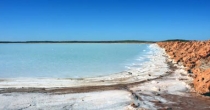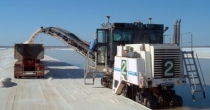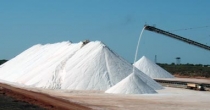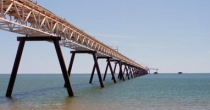Onslow Salt
Construction completed in 1999 on the $80 million Onslow Salt project, Western Australia’s latest solar salt operation and newest resource development project.
At an on-site ground breaking ceremony near Onslow, Resources Development Minister Colin Barnett congratulated Onslow Salt on the start-up of its 2.5 million tonne per annum salt field. Onslow Salt will spent $80 million during the construction phase of the project on solar salt ponds, processing facilities and new port facilities at Onslow. The project was formally approved by the State Government, eight months after being boosted by Netherlands-based chemical company Akzo Nobel, which gave it financial backing.
“This is a major project for the township of Onslow, the Pilbara in general and Western Australia’s reputation as a first class supplier of quality salt,” Mr Barnett said. Mr Barnett said that with the energy needs of the project and its proximity to natural gas, the construction of a gas-fired power station to provide a source of cheaper energy was under consideration.
Located a further 550 kilometers up the coast from Shark Bay, Onslow salt field has an area of approximately 8,600 hectares, or 1,900 times the size of the average baseball stadium, almost double the production capacity of Shark Bay, and port facilities enabling 50,000-ton class ships to berth.
When it emerged that Akzo Nobel was selling its interest in Onslow, Mitsui decided to take the opportunity to become a major shareholder in the salt field. In addition to the sound commercial basis for this decision, Mitsui saw the role that it could play in ensuring a stable supply of salt for major Japanese chlor-alkali manufacturers, as well as manufacturers in other Asian countries, amid increasing concern about salt supply in the Asian market.
The acquisition also enables Mitsui to demonstrate its comprehensive business engineering capabilities through involvement with major chlor-alkali manufacturers at various stages along the value chain, not only supplying the salt that serves as the basic raw material for their chlor-alkali business, but also subsequently purchasing their products and selling them throughout the world.
Mitsui will harness the expertise it has gained through its long involvement in Shark Bay Salt in operating this much larger solar marine salt field, and intends to continue to fulfill its mission of securing stable supply of the resource for the chlor-alkali industry in the future.
The world of salt extends far beyond the saltshaker on your table or salt’s traditional use as a preservative in food processing. In Japan, for instance, table salt and salt for food manufacturing and so forth account for only around 20% of salt use, with the remaining around 80% being used as a raw material for production of caustic soda, chlorine and soda ash in the chlor-alkali industry.
The diverse end uses of caustic soda, chlorine and soda ash indicate just how prevalent and essential salt is in our lives. Caustic soda is used in the manufacture of pulp and paper, textiles, soaps and detergents; chlorine’s applications include the extremely versatile polyurethane plastics used in automobile components, PVC (polyvinyl chloride) employed as a building material, water purification and as a disinfectant; and soda ash is used most commonly in the production of glass.
Since salt is a raw material for many commodities, demand for it is closely tied to economic growth and performance. In China, rapid economic development and the emergence of Chinese chlor-alkali manufacturers has led to soaring demand for industrial-use salt, to the extent that in 2004 China shifted from being a net exporter to a net importer of salt. As a result of such rising demand for salt in China, supply has become tight in Asia.







